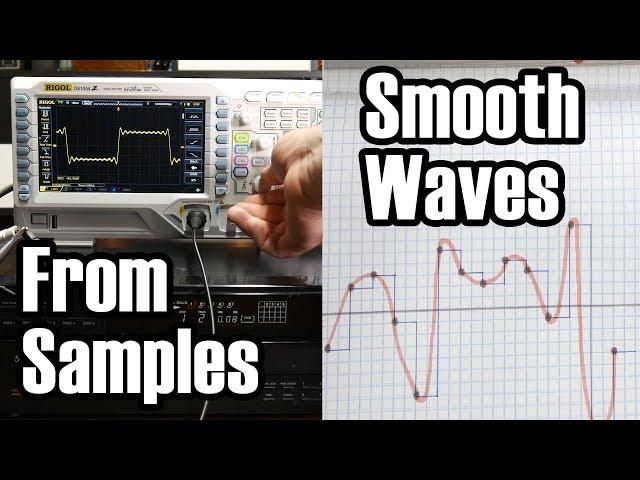
Nyquist-Shannon; The Backbone of Digital Sound
Комментарии:

The one thing that gives me me pause and makes me wonder if audiophiles might be onto something is the notion about what the human ear can hear. It's easy to say that we can only hear 20 megahertz at most, but the ear drum and all the inner ear parts are a physical medium. It's possible that the way the cochlea and neurons process sound might interact differently with the physics of waves that truly aren't sine waves.
Ответить
All this talk about frequency. Now i am getting curious about how volume is recorded digitally.
Ответить
Original article link shows "404"... excellent explanation, used this for signal integrity course in high speed PCB designs.
Ответить
i decided to convert a few hours of surround sound audio into 5.1 channel 32bit 44.1khz per channel....HOLY FUCK MY HARD DRIVE!
i think i'll stick to my 320kbps stereo aac. plenty good enough for my ears yet won't fuck over my available storages.

"Beethoven's 9th... dear..." i see what you did there
Ответить
Really appreciate your covering aliasing as the signal frequency approaches Nyquist.
Ответить
Your explanation didn’t cover bit depth. The passthrough of digital sampling only perfectly recreates the original (band-limited) signal with real-valued samples, but CDs use 16-bit values. So the samples will be slightly inaccurate, with those inaccuracies reproducing a slightly different analogue signal. Is that audible? Also if there’s any digital processing (eg EQ), doesn’t that need increased sample rate and bit depth to not introduce (potentially audible) artefacts around the nyquist freq?
Ответить
Wut, "a low pass filter will get rid of choppys"? Huh? It will get rid of data points below your low pass filter, but it doesnt magically turn stair steps into smooth waves. You say a lot of stuff like that. you just make a statement like "it has to be", no, it doesnt. If i ran a digital recording through a scope without going through a DAC, I'll see square waves.
Ответить
I almost understood
Ответить
Wii control the vertical, we control the horizontal
Ответить
Voktage singularities
Ответить
snake oilers hate him
Ответить
Having done music production since 2017, the term low pass filter is a common term in my vocabulary. There is also the opposite, high pass filter, which eliminates frequencies below a certain point.
Ответить
Your CD will be destroyed if you store it in one of those PVC boxes rather than the traditional plastic jewel boxes. Some albums or labels ship their CDs in those, which over time will decompose and adversely affect the polycarbonate in the CDs, making it hard or impossible to be read by the laser. Happened to me on a couple of CDs even though they were well cared for and kept clean
Ответить
There is so much misinformation in this video ; it is disappointing
Ответить
great video, one of the best on YT
Ответить
@TechnologyConnections Just FYI: The channel that translates your videos into Russian sometimes allows itself to change some facts, for example in the translation of this video Nyquist-Shannon turned into "Kotelnikof"
Ответить
Kotelnikov published his theorem in 1933, Karl, Nyquist only woke up in 1948.
Ответить
Unfortunately, Nyquist never claimed that this works for music, he only claimed that this works for a sinus function. If you built an amplifier that creates a square wave that looks like the one in your thumbnail, it would sound so awful that you would not even consider selling it you would directly take it to the bin.
Ответить
But this would mean that it is not possible to reproduce even approximately, square or saw tooth waves at frequencies above 10 KHz (still well audible), because already at 10 KHz there is only 1 harmonic possible to be used (the one at 20 KHz). the 3rd harmonic is out of range. Then how does square and saw tooth waves at frequencies between 10-20 KHz look like? I guess that all non sine wave forms above 10KHz are rapidly approximated to a sine wave. This would be not acceptable for HI-Fi reproduction. But also with analog medias (vinyl and tapes) it should happen the same, since they have not more bandwidth than a CD (or even if they may have some response above 20 KHz it is extremely attenuated, almost to zero).
Could you please show how non sine waves above 10 KHz are reproduced? It would be very interesting.

There’s also a slight but important detail with the square wave too; you cannot have that instantaneous change in nature period. Regardless of our hearing being limited, the compression waves propagate in a way that causes pressure to have a maximal speed which it can change, not to mention the speed required by whatever membrane used to create the pressure itself. Anyway, while we can have changes that seem near instantaneous to our human ears, you can never have it truly that way in nature.
Ответить
I think possibly the cheapest DACs actually do produce a stair step pattern - I have a 10$ or so usb sound card, and looked at its output in an oscilloscope, and that's exactly what I saw (with the caveat that the end of each step was a bit rounded)
Ответить
I love your videos
Ответить
I totally get it now.Wow.Very well put Thank you
Ответить
I didn't understand a word of that.
Ответить
Even if something doesn't have any mass, it will still not be able to move instantaneously since there is a speed limit for information💜 although, because of how physics works, if you were that massless particle, everything you experience(d) would happen instantaneously from your relative observation point💜 for example, if you were a photon being produced from the center of the sun, it would take between 10,000 years and 50 million years to escape to the surface (depending on what source(s) you've read and researched.) It would feel literally instant from said photon's point of view to travel for that amount of time from our point of view💜 And of course this example only works if we decide that the absorption and release of said photon everytime it runs into an atom, is still the same photon and not a new photon since a photon is nothing more than a "packet" of a specific amount of energy, but of course, that's what's assumed whenever we say "it takes x amount of time for a photon to escape to the surface of the Sun."💜
Ответить
The low pass filter at the output is called the "reconstruction filter".
Fun fact, the input (anti-aliasing filter) and output (reconstruction filter) low pass filters are precision analog components and often the most expensive part of a digital audio system. For this reason, engineers will make the (cheap) digital system that sits between the two quite a bit more capable than it would strictly need to be. This allows them to pull some tricks that in turn allow for less expensive, less capable input and output filters to be used.

I’ve always found 44100 to be a pretty weird number. I was just doing math in my head for fun one day, multiplying prime numbers, and I noticed that 44100 is the first 4 prime numbers squared and multiplied together.
Ответить
It's supposedly actually slightly above twice the highest frequency. Thus, 44100.
Ответить
I've been teaching Music Tech for several years, and yours was the clearest representation of A/D conversion I've seen yet!
Ответить
That Monthy video on digital audio is the holy grail for us who want to learn deeply about the topic, without getting too complicated with the mathematical part of it.
Ответить
I have a question. if you play a sine wave at or just below the sample rabe but offset the phase of the sine wave from the samples. will it produce a signal that has the same frequency but with reduced amplitude.
When buying a oscilloscope engineers recommend that the sampling rate should be 2.5 times higher than the highest signal you expect to measure.
If it is true then the 2x Nyquist rule does not produce a signal perfectly.

I do wish people would stop forgetting the asterisk in the Shannon-Nyquist theorem. You can perfectly reproduce the signal as long as the highest component frequency is less than half your sampling frequency. Specifically, there is an exclusion for a component that is exactly half your sampling frequency.
Reason: imagine a perfect sine wave, and you sample it at exactly twice its frequency... Precisely every time it crosses zero. Now you have a string of zeros that can mean there was no signal, or there was a perfect sine wave at exactly half your sampling frequency, and you always sampled it as it crossed zero. You have no way of knowing - and that's aliasing.
So, a 40kHz sampling frequency cannot sample up to 20 kHz, only up to nineteen point a-large-but-finite-number-of-nines kHz. Yes it's a nitpick, but it is such an obvious "wait what" moment that schoolchildren can see it - I know because I was one of those schoolchildren, and my teacher didn't have an answer.

Some folks may be surprised to learn that the Nyquist-Shannon sampling theorem is also extremely relevant in the field of astrophotography. And for the same reason: it is the digital representation of an analog signal. Amazing how their work in the 1920's is still massive relevant over 100 years later.
Ответить
I HIGHLY recommend the linked video with Monty Montgomery as a follow on to this one!
Ответить
It is worth noting that while following the Nyquist-shannon frequency rule for signal processing will prevent aliasing it will not necessarily perfectly recreate the sampled signal when converting back to analog. When sampling at exactly twice the frequency, wave amplitude information isn't usually preserved. If you consider a pure sine wave with a frequency of 100 Hz being sampled at 200 Hz, only two samples are being taken per cycle, so while frequency information will be retained, as sampling and the wave are in sync, if the time of the sample is anything other than the max and min of the wave the amplitude of the wave will be lost in the sample. As samplers aren't perfect and there time can wander a bit you will end up with a modulating amplitude in the signal, as you increase the sample rate amplitude modulation decreases, but you have to go a fair bit above double the frequency for it to go away entirely.
Audio signals are rarely a pure and perfect wave though, so it's not really an issue that affects audio signals too often; but for other signal processing applications it's usually better to go way above that frequency. I think a good rule of thumb is 10x the signal frequency, but I wouldn't have thought it would help audio that much, if at all. It would be very interesting to see a video on aliasing, the main reason for the nyquist-shannon theorem and a very interesting phenomenon

i watched this video a year ago. it was all Greek, im afraid. However, after a year in which Ive bought oodles of components, and ICs, an oscilloscope, a function generator, and a soldering iron, then watched all the electro-boom videos again and again, i now get 90% of the video. comprehending a previously incomprehensible thing is the most fantastic feeling. cheers.
Ответить
I'm really nerding out on [SQ] car audio right now and was looking for examples of the words' definitions I was just reading. I feel like I'm slightly less insane now, because of this video in particular, after deep diving [thanks adhd] on wiki 😅
Just trying to figure out how much detail, these damn audiophiles keep talking about, actually matters lol I feel like FLAC files etc are kind of a waste of time... They also go crazy about fiber optic cables and after watching your video on that I'm thinking I should be using HDMI cables instead lmfao (maybe the interference rejection of optical helps in the harsh environment of a car 🤔)
I've been watching your channel for a bit now and was surprised to see you had done a video on this complex topic; thanks!

The "staircase", majority of average joe doesn't understand it: They don't have the mathematics but the explanation here was good. Other thing people don't understand the cumulative superposition of every component "transfer function", even the room has one! So they will prefer some "superposition", even if the signal is more distorted. Just take tube amps, many of them are not even linear but yet, some people will praise them! That's ok until you throw your money out of the window believing false claims.
Ответить
About the graphs of square waves — I’m reminded how a plot of a vertical line has “no slope” because you’d be dividing by zero.
Ответить
Love this channel wierd that Fl linked me to this
Ответить
An eye for an eye will only make the whole world blind -Gandhi
Ответить
I got into audio after seeing this video, and I have to thank you for keeping me out of the hi-res rabbit hole. Because of this I knew that there isn’t a perceptible quality increase above 44.1khz or 48khz
Ответить
What if your source sound has a 20kHz and a 10kHz sound, but they are out of phase by, say, 1/8th the sampling frequency? Wouldn't you need 8x more samples to make sure they are reproduced in the same phase they were recorded?
Ответить
Gonna have to watch this a few more times 🤯
Ответить
CD rot
Ответить
brilliant, as usual.
Ответить
You should make a video on FFT
Ответить

























